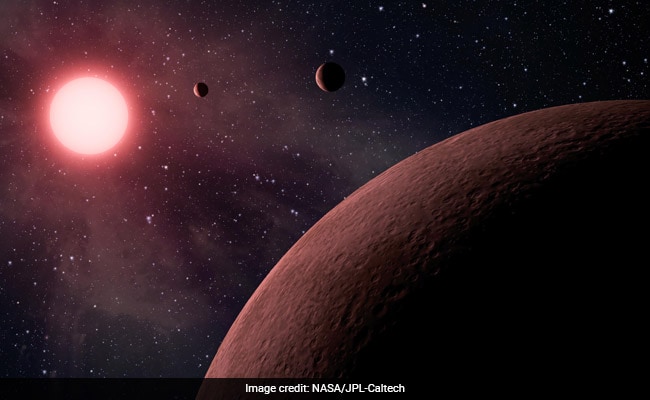
Kepler-1658b, located 2,600 light-years from Earth, is known as “hot Jupiter”. (representative)
Paris:
For the first time astronomers have identified a planet spiraling toward a catastrophic collision with the aging Sun, potentially offering a glimpse into how Earth might one day end.
In a new study published Monday, a team of US-based researchers say they hope the doomed exoplanet Kepler-1658b can help shed light on how worlds die as their stars age.
Kepler-1658b, located 2,600 light-years from Earth, is known as the “hot Jupiter” planet.
While the planet is similar in size to Jupiter, it orbits its host star about one-eighth the distance between our sun and Mercury, making it much hotter than the gas giant in our solar system.
Kepler-1658b’s orbit around its host star takes less than three days — and gets shorter by about 131 milliseconds per year, according to the study, published in Astrophysical Journal Letters.
“If it continues spiraling toward its star at the observed rate, the planet will collide with its star in less than three million years,” said Shreyas Visapragada, a postdoctoral researcher at the Harvard-Smithsonian Center for Astrophysics and lead author of the study.
“This is the first time we have observed direct evidence of a planet spiraling towards its developing star,” he told AFP.
An evolving star has entered a “giant” phase of the stellar life cycle, when it begins to expand and become brighter.
Kepler-1658b’s orbit is shortened by tides, in a process similar to how Earth’s oceans rise and fall each day.
This gravitational push and pull can work in both directions – for example, the Moon is rising very slowly away from Earth.
Earth’s final farewell? –
Could the Earth be heading towards a similar doom?
“Death by a star is a fate believed to await many worlds and could be Earth’s final farewell billions of years from now as our sun ages,” the Astrophysics Center said in a statement.
“In five billion years or so, the Sun will evolve into a red giant star,” Visapragada said.
While the tidal-driven processes seen on Kepler-1658b “will drive the decay of Earth’s orbit toward the sun,” this effect can be counterbalanced by the loss of the sun’s mass, he said.
“The ultimate fate of the Earth is somewhat unclear,” he added.
Kepler-1658b was the first exoplanet spotted by the Kepler space telescope, which was launched in 2009. However, it took nearly a decade of work before the planet’s existence was confirmed in 2019, according to the Center for Astrophysics.
Over the course of 13 years, astronomers have been able to observe the slow but steady change in the planet’s orbit as it crosses the face of its host star.
One of the “big surprises” is that the planet itself is so bright, Visapragada said.
He said this was previously thought to be due to it being a particularly reflective planet.
But researchers now believe that the planet itself is much hotter than expected, possibly due to the same forces that push it toward its star.
(Except for the headline, this story was not edited by the NDTV staff and was published from a syndicated feed.)
Featured video of the day
‘Watch With Your Daughter’: Madhya Pradesh Speaker Shah Rukh Khan on Pathan Row




More Stories
Boeing May Not Be Able to Operate Starliner Before Space Station Is Destroyed
Prehistoric sea cow eaten by crocodile and shark, fossils say
UNC student to become youngest woman to cross space on Blue Origin